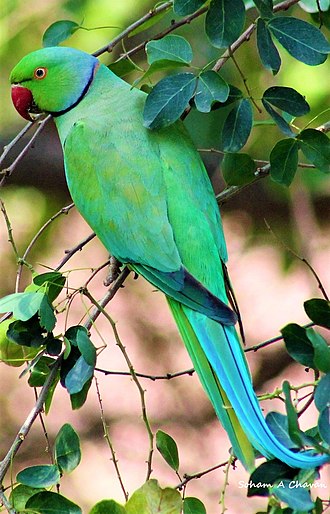Characteristic features of parrots include a strong, curved bill, an upright stance, strong legs, and clawed zygodactyl feet. Many parrots are vividly coloured, and some are multi-coloured. Most parrots exhibit little or no sexual dimorphism in the visual spectrum. They form the most variably sized bird order in terms of length.
Psittaciform diversity in South America and Australasia suggests that the order may have evolved in Gondwana, centred in Australasia. The scarcity of parrots in the fossil record, however, presents difficulties in confirming the hypothesis. There is currently a higher amount of fossil remains from the northern hemisphere in the early Cenozoic. Molecular studies suggest that parrots evolved approximately 59 million years ago (Mya) (range 66–51 Mya) in Gondwana. The three major clades of Neotropical parrots originated about 50 Mya (range 57–41 Mya).
A single 15 mm (0.6 in) fragment from a large lower bill (UCMP 143274), found in deposits from the Lance Creek Formation in Niobrara County, Wyoming, had been thought to be the oldest parrot fossil and is presumed to have originated from the Late Cretaceous period, which makes it about 70 million years old. However, other studies suggest that this fossil is not from a bird, but from a caenagnathid oviraptorosaur (a non-avian dinosaur with a birdlike beak), as several details of the fossil used to support its identity as a parrot are not actually exclusive to parrots, and it is dissimilar to the earliest-known unequivocal parrot fossils.
It is generally assumed that the Psittaciformes were present during the Cretaceous–Paleogene extinction event (K-Pg extinction), 66 mya. They were probably generalised arboreal birds, and did not have the specialised crushing bills of modern species. Genomic analysis provides strong evidence that parrots are the sister group of passerines, forming the clade Psittacopasserae, which is the sister group of the falcons.
Living species range in size from the buff-faced pygmy parrot, at under 10 g (0.4 oz) in weight and 8 cm (3.1 in) in length,: 149 to the hyacinth macaw, at 1 m (3.3 ft) in length, and the kakapo, at 4.0 kg (8.8 lb) in weight. Among the superfamilies, the three extant Strigopoidea species are all large parrots, and the cockatoos tend to be large birds, as well. The Psittacoidea parrots are far more variable, ranging the full spectrum of sizes shown by the family.
The most obvious physical characteristic is the strong, curved, broad bill. The upper mandible is prominent, curves downward, and comes to a point. It is not fused to the skull, which allows it to move independently, and contributes to the tremendous biting pressure the birds are able to exert. A large macaw, for example, has a bite force of 35 kg/cm2 (500 lb/sq in), close to that of a large dog. The lower mandible is shorter, with a sharp, upward-facing cutting edge, which moves against the flat portion of the upper mandible in an anvil-like fashion. Touch receptors occur along the inner edges of the keratinised bill, which are collectively known as the "bill tip organ", allowing for highly dexterous manipulations. Seed-eating parrots have a strong tongue (containing similar touch receptors to those in the bill tip organ), which helps to manipulate seeds or position nuts in the bill so that the mandibles can apply an appropriate cracking force. The head is large, with eyes positioned high and laterally in the skull, so the visual field of parrots is unlike any other birds. Without turning its head, a parrot can see from just below its bill tip, all above its head, and quite far behind its head. Parrots also have quite a wide frontal binocular field for a bird, although this is nowhere near as large as primate binocular visual fields. Unlike humans, the vision of parrots is also sensitive to ultraviolet light.
Numerous challenges are found in studying wild parrots, as they are difficult to catch and once caught, they are difficult to mark. Most wild bird studies rely on banding or wing tagging, but parrots chew off such attachments. Parrots also tend to range widely, and consequently many gaps occur in knowledge of their behaviour. Some parrots have a strong, direct flight. Most species spend much of their time perched or climbing in tree canopies. They often use their bills for climbing by gripping or hooking on branches and other supports. On the ground, parrots often walk with a rolling gait.
The diet of parrots consists of seeds, fruit, nectar, pollen, buds, and sometimes arthropods and other animal prey. The most important of these for most true parrots and cockatoos are seeds; the large and powerful bill has evolved to open and consume tough seeds. All true parrots, except the Pesquet's parrot, employ the same method to obtain the seed from the husk; the seed is held between the mandibles and the lower mandible crushes the husk, whereupon the seed is rotated in the bill and the remaining husk is removed. They may use their foot sometimes to hold large seeds in place. Parrots are granivores rather than seed dispersers, and in many cases where they are seen consuming fruit, they are only eating the fruit to get at the seed. As seeds often have poisons that protect them, parrots carefully remove seed coats and other chemically defended fruit parts prior to ingestion. Many species in the Americas, Africa, and Papua New Guinea consume clay, which releases minerals and absorbs toxic compounds from the gut.
